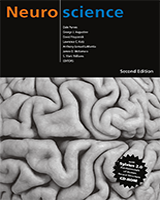By agreement with the publisher, this book is accessible by the search feature, but cannot be browsed.
NCBI Bookshelf. A service of the National Library of Medicine, National Institutes of Health.
Purves D, Augustine GJ, Fitzpatrick D, et al., editors. Neuroscience. 2nd edition. Sunderland (MA): Sinauer Associates; 2001.

Neuroscience. 2nd edition.
Show detailsOverview
The subjective feelings and associated phsyiological states known as emotions are essential features of normal human experience. Moreover, some of the most devastating psychiatric problems involve emotional (affective) disorders. Although everyday emotions are as varied as happiness, surprise, anger, fear, and sadness, they share some common characteristics: All emotions are expressed through both visceral motor changes and stereotyped somatic motor responses, especially movements of the facial muscles. These responses accompany subjective experiences that are not easily described, but which are much the same in all human cultures. Emotional expression is closely tied to the visceral motor system, and therefore entails the activity of all of the central brain structures that govern the preganglionic neurons in the brainstem and spinal cord. Historically, the neural centers that coordinate emotional responses have been grouped under the rubric of the limbic system. More recently, however, several brain regions in addition to the classical limbic system have been shown to play a pivotal role in emotional processing, including the amygdala and several cortical areas in the orbital and medial aspects of the frontal lobe. This broader constellation of cortical and subcortical regions encompasses not only the central components of the visceral motor system but also regions in the forebrain and diencephalon that motivate lower motor neuronal pools concerned with the somatic expression of emotional behavior. Effectively, the concerted action of these diverse brain regions constitutes an emotional motor system.
- Physiological Changes Associated with Emotion
- The Integration of Emotional Behavior
- The Limbic System
- The Importance of the Amygdala
- The Relationship between Neocortex and Amygdala
- Cortical Lateralization of Emotional Functions
- The Interplay of Emotion and Reason
- Summary
- Additional Reading
- Emotions - NeuroscienceEmotions - Neuroscience
- ZNF41 zinc finger protein 41 [Homo sapiens]ZNF41 zinc finger protein 41 [Homo sapiens]Gene ID:7592Gene
- Gene Links for GEO Profiles (Select 5794353) (1)Gene
- Homologene neighbors for GEO Profiles (Select 55646200) (0)GEO Profiles
- Homologene neighbors for GEO Profiles (Select 48718072) (0)GEO Profiles
Your browsing activity is empty.
Activity recording is turned off.
See more...